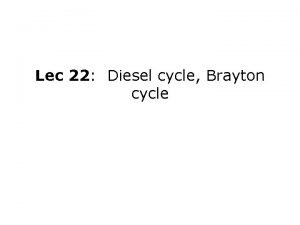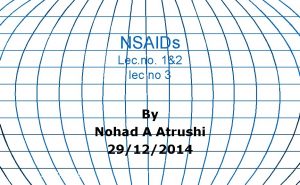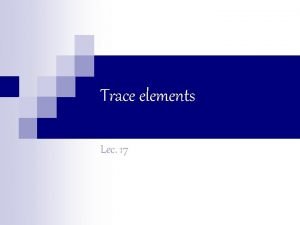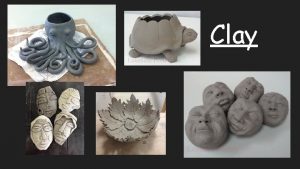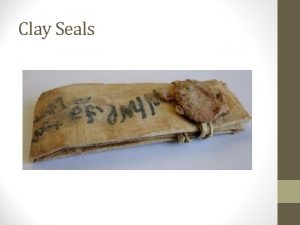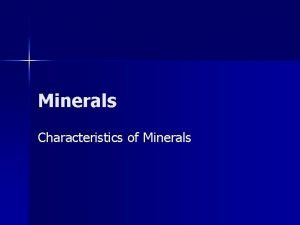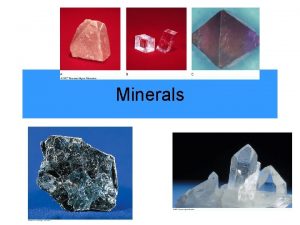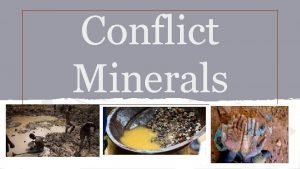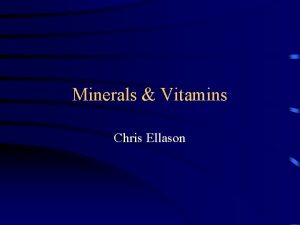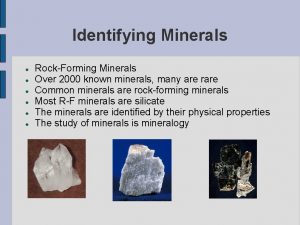Lec 1 Clay minerals Clay material Clay is












- Slides: 12

Lec. 1 Clay minerals

Clay material: Clay is a nature material of very fine texture, usually plastic when wet, hard and compact when dry Consists mainly of fine mineral particles less than (4) microns in size, that have platy characters and large surface area.

In addition to clay minerals, clay material contains adifferent ratio of non-clay minerals, like: quartz, feldspar, pyrite, iron oxides, organic matter, soluble salts, calcite, dolomite, gibbsite. Clay can also be a particle-size term: 0. 062 -0. 004 mm. = silt less than 0. 004 mm. = clay (Wentworth scale) Soil scientists international classification (1951) =0. 002 mm.

The concept of clay minerals; The clay minerals are hydrous aluminum silicates more specifically phyllosilicates (some are inosilicates), with Mg or Fe substituting completely or partly for the Al in some of them, while alkaline ions may essentially be present in some. They are chemically and structurally similar to other phyllosilicates, such as micas. Clay are Essentially, weathering products of disintegration and chemical decomposition, detrital sediment or biogenetical, and also are abundant in hydrothermal alteration zones associated with igneous and metamorphic rocks.

The clay minerals cycle: 1 - weathering 2 - sedimentation 3 - burial 4 - metamorphism (deep burial), or igneous environment 5 - Uplift Factors controlling properties of clay material: 1 - clay minerals proportion and composition 2 - crystallinity of clay mineral particles 3 - non- clay mineral constituents 4 - organic matter content 5 - exchangeable ions 6 - soluble salts 7 - texture: A- grain size (lab. no. l) B-particle morphology C- particle orientation and binding forces: i- face to face contacts ii- edge to edge contacts iii- edge to face contacts

When face to face common ……. ……. aggregation When edge to edge, or edge to face common ……. flocculation (flocks in suspension) when particles are separated ……. dispersion

Dispersion: Due to negative charge within clay particles, the positive charge will be surround it to neutralizing, this will produce a negative cloud around particle, then cause repulsion between them and dispersion. + ve: Ca, Na, H _ ve : C 03, Cl, OH

Flocculation; ; Flocculation; When high electrical conductivity ions are present, like (HCl , Na. Cl), the particles will be attracted to this media, then flocculate.

Why are clay minerals so important? If we look at the volume of material at the earth's surface we see that clay minerals constitute about 16% of its total. The upper 20 km is considered the surface because it is the region from which we extract natural resources. The diagram below graphically explains how the value of 16% is obtained.

Scientific uses of clay minerals: • Stratigraphic correlation and depositional environment study. • Well logging. • At dispersion, it reduces the permeability of sandstone. • The organic matter in clay may convert to hydrocarbons. • It is important for agricultural soils. • Study and interpret the engineering properties for soil. Industrial uses of clay minerals: 1 -Ceramic industry; moldable when wet, hard when dried, vitrified when fired. It is a basic raw material in: a- White ware b- -Structural products (brick) c- Fire brick

2 - Paper, rubber, paint. . . etc. • 3 - Drilling mud (Na-Bentonite). 4 - Fuller's earth (Palygorskite). 5 - Cement industry. 6 - Lightweight aggregates. 7 - Radioactive waste preservation (Montmorillonite). 8 - Spreading an oil floor in factories (Palygorskite). 9 - As a source for aluminum (Bauxite). 10 - Insecticides (Kaolinite and Palygorskite).







